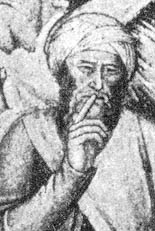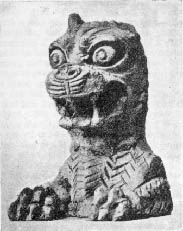
In a letter to Clark Ashton Smith - 27 November 1927 - H.P. Lovecraft asserts that the last original of Al Azif in Arabic was lost before 1228: new evidence shows that it survived into the XVII Century, and suggest it may still be extant in Salamanca. A translation into Spanish of the Arabic original was catalogued in a Buenos Aires Library as recently as 1951 . . .
Johannes Hispalensis, also known as Avendath, a converted Jewish physician and a member the Toledo school of translators, acquired in 1164 the medical library of the andalusí Ibn Yulyul, whom in the second half of the Xth Century prospered at the service of Hishâm II. Amongst the medical texts and herbariums, Johannes found a copy in Arabic of the Al Azif. Not a man inclined to religious pursuits, Johannes gave the book to the scholar Abd-Al-Kadir Guilânî. A profoundly devout muslim, Guilânî realised the blasphemous nature of the book and, torn between his religious duty to destroy it and that strange compulsion most scholars have to preserve the written word, Al-Kadir sealed the book and entrusted it for safe keeping to Abdel Haqq, secretary of the Caliph of Cordoba. Soon after Guilânî entered into a delirious comma and died in 1166. [1]
The Al Azif must have remained in Cordoba until the city was re-conquered by the Christians in 1236 and the library of the Mezquita taken by Alonso de Ojeda to Salamanca. In the XVIth Century, León de Sagredo, a converso native of Tárrega, translated the Al Azif extant at Salamanca to the Spanish romance as "El Libro De Los Antiguos Demonios Escrito por el Arabe Abdul Hazred." An entry in a catalogue of the time reads "Impreso a la gloria de Sancta Catherina, gloriosa Virgen Patrona de la Universidad de Salamanca, por Cornelio Bonardo. Año del Señor de 1512." [2] There is no evidence how many copies were printed.
|
It is interesting to note that the title of this translation – "the book of the ancient demons" – renders more accurately the Arabic original semantics than does the Greek word "Necronomicon" chosen by Theodorus Philetas. Another interesting fact is the spelling of Abdul Hazred: the idiomatic difficulties of the construction "Abdul Alhazred" are well known as the name Abdul already includes the prefix Al’ in [Al]hazred thus implying an unnecessary redundancy never used in Arabic.
In 1559, the Holy Inquisition’s Index – the list of prohibited books - included this translation in the list of heretical books and, as late as 1623, the Tribunal of Toledo, at the request of the Holy Office ordered the burning, amongst other titles, of copies of the Spanish translation of Al Azif. However, there is no record that the original Arabic text itself was ever destroyed, nor does the 1559 or subsequent Indexes mention it. [3] The current University’s Library catalogue has no record of the original Arabic version of Al Azif or of its Spanish translation.
In 1952, the "Biblioteca Nacional" of Buenos Aires, in its old "Anexo" of Avenida Santa Fe 1851, had a copy of the translation catalogued as "Sagredo, León. El Libro De Los Antiguos Demonios Escrito por el Arabe Abdul Hazred, Salamanca, 1612." [4]
The catalogue entry is puzzling. Firstly the year is quoted as 1612 while Freyre de Andrada attributes a date of 1512 to the publication of de Sagredo’s translation. Secondly, the mention of Palau is enigmatic as this bibliographer does not seem to have ever catalogued the Al Azif or El Libro De Los Antiguos Demonios Escrito por el Arabe Abdul Hazred. Furthermore, Palau never worked in Buenos Aires: is this a reference to another, yet undiscovered, copy of the Spanish translation?
The "Anexo" was closed in 1978 when the building was declared unsafe and condemned to demolition. The collections were transferred to the library of the "Servicio Geologico Nacional" in the second floor of the "Secretaria de Industria Comercio y Mineria" en Avenida Julio A. Roca 651 in Buenos Aires. However the modern catalogue does not list El Libro De Los Antiguos Demonios Escrito por el Arabe Abdul Hazred in its current holdings.
|
Dr Carlos Sorentino,
Ph D, M Env St, B E (Chem), Dip Rad Tech
FAusIMM, CPMan, CPEnv, MMICA, MRACI, CChem
Macquarie University
April 2001
Footnotes
- Aïnî, Mehmmed Ali: Un grand Saint de l'Islam Abd-Al-Kadir Guilânî 1077-1166. En collaboration avec F. J. Simore-Munir. Les grandes figures de l'Orient, 6. Paris 1936.
- Freyre de Andrada, Jacinto. Catalogo General de la Biblioteca de la Santa Merced del Monte de la Real Universidad de Salamanca …. 1651.
- Kamen, H., 1998, The Spanish Inquisition, The Folio Society, London.
- The rest of the entry reads: "Folio menor. Frontis grabado, 6 hojas, retrato grabado, 67 hojas. Piel de la época con tejuelo, nervios y hierros dorados en el lomo con pequeña pérdida en el cabezal. Cortes tintados. Las primeras y últimas hojas con algunos puntos de polilla restaurados que afectan mínimamente. 6 hojas. 67 páginas Algo justo de margen. Este ejemplar está falto de las estampas 14 y 15. El frontispicio y la portada originales han sido substituídas por una portada manuscrita de la época en castellano. Ejemplar descripto por Palau."
Return to Cthulhu Mythos home page
© This article copyright 2001 by Carlos Sorentino. Send comments to csorentino@optusnet.com.au

